年处理量18万吨苯—甲苯混合液的连续精馏塔的设计
年处理量18万吨苯—甲苯混合液的连续精馏塔的设计
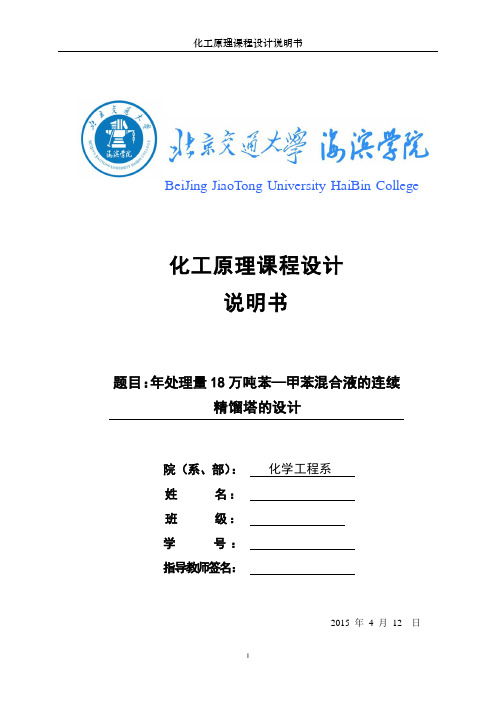
BeiJing JiaoTong University HaiBin College化工原理课程设计说明书题目:年处理量18万吨苯—甲苯混合液的连续精馏塔的设计院(系、部):化学工程系姓名:班级:学号:指导教师签名:2015 年4 月12 日摘要目前用于气液分离的传质设备主要采用板式塔,对于二元混合物的分离,应采用连续精馏过程。
浮阀塔在操作弹性、塔板效率、压降、生产能力以及设备造价等方面都比较优越。
其主要特点是在塔板的开孔上装有可浮动的浮阀,气流从浮阀周边以稳定的速度水平进入塔板上液层进行两相接触,浮阀可根据气体流量的大小上下浮动,自行调节。
其中精馏塔的工艺设计计算包括塔高、塔径、塔板各部分尺寸的设计计算,塔板的布置,塔板流体力学性能的校核及绘出塔板的性能负荷图。
关键词:气液传质分离;精馏;浮阀塔ABSTRACTCurrently,the main transferring equipment that used for gas-liquid separation is tray column. For the separation of binary, we should use a continuous process. The advantages of the float value tower lie in the flexibility of operation, efficiency of the operation, pressure drop, producing capacity, and equipment costs. Its main feature is that there is a floating valve on the hole of the plate, then the air can come into the tray plate at a steady rate and make contract with the level of liquid, so that the flow valve can fluctuate and control itself according to the size of the air. The calculations of the distillation designing include the calculation of the tower height, the tower diameter, the size of various parts of the tray and the arrangement of the tray, and the check of the hydrodynamics performance of the tray. And then draw the dray load map.Key words:gas-liquid mass transfer;rectification;valve tower目录摘要 (I)ABSTRACT (II)1 绪论 (1)2 设计方案的确定 (3)2.1 设计流程 (3)2.2 设计要求 (3)2.3 设计思路 (4)2.4 相关符号说明 (5)3 塔板的工艺设计 (6)3.1 设计方案的确定 (6)3.2 塔的工艺计算 (6)3.2.1 物料衡算 (6)3.2.2 精馏塔的气液相负荷 (8)3.2.3 操作线方程 (9)3.2.4 用逐板法算理论板数 (9)3.2.5 实际板数的求取 (10)3.3 精馏塔的工艺条件及有关物性数据的计算 (11)3.3.1 进料温度的计算 (11)3.3.2 操作压强 (11)3.3.3 平均摩尔质量 (11)3.3.4 平均密度计算 (12)3.3.5 液体平均表面张力的计算 (14)3.3.6 液体平均黏度计算 (14)3.4 精馏塔工艺尺寸的计算 (15)3.4.1 塔径的计算 (15)3.4.2 精馏塔有效高度的计算 (17)3.5 塔板主要工艺尺寸的计算 (18)3.5.1 精馏段溢流装置计算 (18)3.5.2 提馏段溢流装置计算 (20)3.6 塔板流体力学验算 (22)3.6.1 精馏段流体力验算 (22)3.6.2 提馏段流体力验算 (24)3.7 塔板负荷性能图 (26)3.7.1 精馏段负荷性能图 (26)3.7.2 提馏段负荷性能图 (29)4 热量衡算 (32)4.1 相关介质的选择 (32)4.1.1 加热介质的选择 (32)4.1.2 冷凝剂 (32)4.2 蒸发潜热衡算 (32)4.2.1 塔顶热量 (32)4.2.2 塔底热量 (33)4.3 焓值衡算 (35)5 辅助设备的选型 (38)5.1 冷凝器的选型 (38)5.2 冷凝器的传热面积和冷却水的用量 (38)5.3 选用釜式再沸器 (39)6 塔附件设计计算 (40)6.1 接管 (40)6.1.1 进料管 (40)6.1.2 回流管 (40)6.1.3 塔顶蒸汽接管 (41)6.1.4 釜液排出管 (41)6.1.5 塔釜进气管 (42)6.2 塔总体高度的设计 (42)7 安全与环保 (43)7.1 安全注意事项 (43)7.2 环境保护 (43)8 结论 (45)设计体会 (46)参考文献 (47)附录: (47)附录一:塔板 (47)附录二:精馏塔 (48)1 绪论为了加强工业技术的竞争力,长期以来,各国都在加大塔的研究力度。
苯_甲苯连续板式精馏塔的设计方案
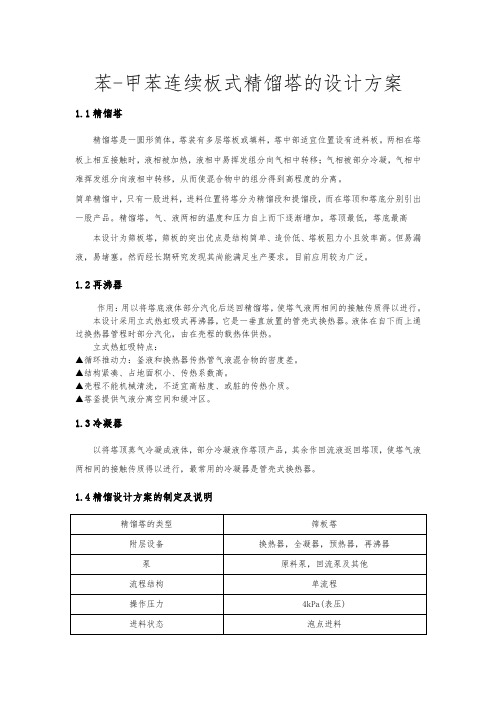
苯-甲苯连续板式精馏塔的设计方案1.1精馏塔精馏塔是一圆形筒体,塔装有多层塔板或填料,塔中部适宜位置设有进料板。
两相在塔板上相互接触时,液相被加热,液相中易挥发组分向气相中转移;气相被部分冷凝,气相中难挥发组分向液相中转移,从而使混合物中的组分得到高程度的分离。
简单精馏中,只有一股进料,进料位置将塔分为精馏段和提馏段,而在塔顶和塔底分别引出一股产品。
精馏塔,气、液两相的温度和压力自上而下逐渐增加,塔顶最低,塔底最高本设计为筛板塔,筛板的突出优点是结构简单、造价低、塔板阻力小且效率高。
但易漏液,易堵塞。
然而经长期研究发现其尚能满足生产要求,目前应用较为广泛。
1.2再沸器作用:用以将塔底液体部分汽化后送回精馏塔,使塔气液两相间的接触传质得以进行。
本设计采用立式热虹吸式再沸器,它是一垂直放置的管壳式换热器。
液体在自下而上通过换热器管程时部分汽化,由在壳程的载热体供热。
立式热虹吸特点:▲循环推动力:釜液和换热器传热管气液混合物的密度差。
▲结构紧凑、占地面积小、传热系数高。
▲壳程不能机械清洗,不适宜高粘度、或脏的传热介质。
▲塔釜提供气液分离空间和缓冲区。
1.3冷凝器以将塔顶蒸气冷凝成液体,部分冷凝液作塔顶产品,其余作回流液返回塔顶,使塔气液两相间的接触传质得以进行,最常用的冷凝器是管壳式换热器。
1.4精馏设计方案的制定及说明1.5基础数据的搜集表1 苯和甲苯的物理性质L表8常压下苯——甲苯的气液平衡数据2.工艺计算2.1生产要求:原料液组成:苯34.5%(wt%)。
产品中:苯含量98.5% 残夜中:苯含量1%2.2塔的物料衡算:料液及塔顶.塔底产品含苯摩尔分数:011.013.92/9911.111.781987.013.925.111.785.9811.785.98383.013.925.6511.785.3411.785.34=+==+==+=w D f x x x平均摩尔质量:Mf=0.383⨯78.11+(1-0.383)⨯92.13=86.767kg/mol Md=0.987⨯78.11+(1-0.987)⨯92.13=78.29kg/mol Mw=0.011⨯78.11+(1-0.011) ⨯92.13=91.98kg/mol 物料衡算:总物料衡算 : D+W=F易挥发组分物料衡算 : D ×Xd+W ×Xw=F ×XfF=33.3*1038.03386.767=kmol/h D=14.497kmol/h W=23.536kmol/h设计成泡点进料后: min 0.6080.9871.680.3830.608F D F F y x R x y --===-- (查得Xf=0.383时Yf=0.608)2.3理论板层数NT 的求取min R =1.68由逐板计算法借助EXCEL 算出各个回流比下理论塔板数:y=0.686x+0.310 1.5100.00561 y'=1.510x-0.00561 y=0.702x+0.294 1.484 0.00533 y'=1.484x-0.00533 y=0.716x+0.280 1.461 0.00507 y'=1.461x-0.00507 y=0.729x+0.267 1.440 0.00484 y'=1.440x-0.00484 y=0.759x+0.238 1.392 0.00431 y'=1.392x-0.00431 y=0.751x+0.245 1.403 0.00444 y'=1.403x-0.00444 y=0.761x+0.235 1.387 0.00426 y'=1.387x-0.00426 y=0.771x+0.2261.372 0.00410 y'=1.372x-0.00410相平衡方程为: 2.47 1.47nn ny x y =-R NTR NT*(R+1) 1.2Rmin 21 2.016 63.3360 1.3Rmin 21 2.184 66.8640 1.4Rmin 19 2.352 63.6880 1.5Rmin 18 2.520 63.3600 1.6Rmin 17 2.688 62.6960 1.7Rmin 16 3.142 66.2656 1.8Rmin 16 3.024 64.3840 1.9Rmin 16 3.192 67.0720 2.0Rmin 16 3.360 69.7600图1 最优回流比的选择由图可得最优回流比R=1.6Rmin=2.688 由图得NT =17(包括再沸器)。
苯甲苯连续精馏塔的设计
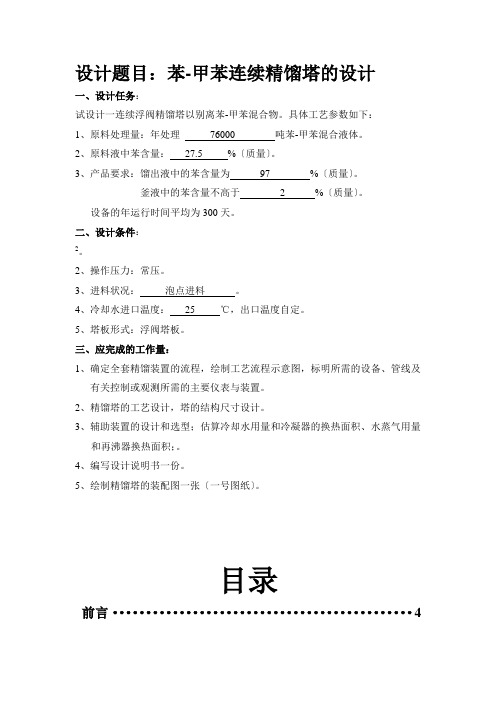
设计题目:苯-甲苯连续精馏塔的设计一、设计任务:试设计一连续浮阀精馏塔以别离苯-甲苯混合物。
具体工艺参数如下:1、原料处理量:年处理76000 吨苯-甲苯混合液体。
2、原料液中苯含量:27.5 %〔质量〕。
3、产品要求:馏出液中的苯含量为97 %〔质量〕。
釜液中的苯含量不高于 2 %〔质量〕。
设备的年运行时间平均为300天。
二、设计条件:2。
2、操作压力:常压。
3、进料状况:泡点进料。
4、冷却水进口温度:25 ℃,出口温度自定。
5、塔板形式:浮阀塔板。
三、应完成的工作量:1、确定全套精馏装置的流程,绘制工艺流程示意图,标明所需的设备、管线及有关控制或观测所需的主要仪表与装置。
2、精馏塔的工艺设计,塔的结构尺寸设计。
3、辅助装置的设计和选型;估算冷却水用量和冷凝器的换热面积、水蒸气用量和再沸器换热面积;。
4、编写设计说明书一份。
5、绘制精馏塔的装配图一张〔一号图纸〕。
目录前言 (4)设计说明 (7)(一)设计方案确实定 (10)1.操作压力〔加压、常压、减压〕 (10)2.进料方式〔热状况〕 (10)3.加热方式〔直接或间接〕 (10) (11) (11) (11) (13)(二)精馏塔的工艺设计计算及结构设计 (14)1.原始液:苯——甲苯的混合物 (14) (14) (15) (20) (23) (24) (35) (39) (43)前言精馏的根本原理是根据各液体在混合液中的挥发度不同,采用屡次局部汽化和屡次局部冷凝的原理来实现连续的高纯度别离。
在现代的工业生产中已经广泛地应用于物系的别离、提纯、制备等领域,并取得了良好的效益。
其中主要包括板式塔和填料塔,而板式塔的塔板类型主要有泡罩塔板、浮阀塔板、筛板塔板、舌形塔板、网孔塔板、垂直塔板等等,精馏过程与其他蒸馏过程最大的区别,是在塔两端同时提供纯度较高的液相和气相回流,为精馏过程提供了传质的必要条件。
提供高纯度的回流,使在相同理论板的条件下,为精馏实现高纯度的别离时,始终能保证一定的传质推动力。
苯甲苯连续精馏塔的工艺设计(浮阀塔)

目录第1章前言 (3)1.1设计题目 (3)1.2精馏及精馏流程 (3)1.3精馏的分类 (4)1.4精馏操作的特点 (4)1.5塔板的类型与选择 (5)1.6相关符号说明 (5)第2章精馏塔的精馏段的设计计算 (7)2.1设计方案的确定 (7)2.2精馏塔的物料衡算 (7)2.2.1原料液及塔顶、塔底产品的摩尔分数 (7)2.2.2原料液及塔顶、塔底产品的平均摩尔质量 (7)2.2.3物料衡算 (8)2.3塔板数的确定 (8)2.3.1理论板层数的确定 (8)2.3.2实际板层数求取 (10)2.4精馏塔的精馏段工艺条件及有关物性数据的计算 (11)2.4.1精馏段的操作压力 (11)2.4.2精馏段的操作温度 (11)2.4.3精馏段气、液混合物的平均摩尔质量 (11)2.4.4精馏段气、液相的平均密度 (12)2.4.5精馏段液相平均表面张力 (12)2.5精馏段的塔体工艺尺寸计算 (13)2.5.1精馏段塔径和实际空塔气速的确定 (13)2.5.2精馏段精馏塔有效高度的求取 (15)2.6精馏段塔板主要工艺尺寸的计算 (15)2.6.1精馏段溢流装置性能参数的确定 (15)2.6.2精馏段塔板布置及浮阀的数目与排列 (16)2.7精馏段塔板流体力学验算 (18)2.7.1精馏段气相通过浮阀塔板的压降 (18)2.7.2精馏段降液管中清夜层高度的确定 (19)2.8精馏段塔板负荷性能图 (20)2.8.1精馏段雾沫夹带线 (20)2.8.2精馏段液泛线 (21)2.8.3精馏段液相负荷上限线 (22)2.8.4精馏段漏液线 (22)2.8.5精馏段液相负荷下限线 (22)第3章浮阀塔板工艺设计结果一览表 (24)第4章设计过程的评述和讨论 (25)4.1回流比的选择 (25)4.2塔高和塔径 (25)4.3精馏塔的操作和调节 (25)第5章塔附件设计 (26)5.1附件的计算 (26)5.1.1接管 (26)5.1.2筒体与封头 (27)参考文献 (29)课程设计心得 (30)第1章前言1.1 设计题目苯-甲苯连续精馏塔的工艺设计(浮阀塔)1.2 精馏及精馏流程精馏是多级分离过程,即同时进行多次部分汽化和部分冷凝的过程。
化工原理课程设计--苯-甲苯连续筛板式精馏塔的设计
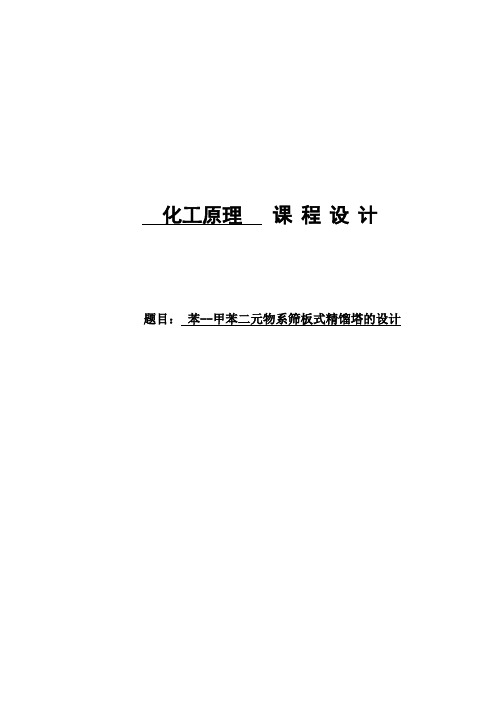
0.0045
0.458
0.472
0.489
0.503
由上表数据可作出漏液线1
3.6.2 液沫夹带线
以 为限,求出 关系如下:
由
精馏段:
,
整理得:
在操作范围内,任取几个 值,依上式计算出 值
表2-4
0.0006
0.0015
0.0030
0.0045
2.457
2.362
2.24
2.138
提馏段:
提馏段:
板上不设进口堰,
故在本设计中不会发生液泛现象
3.6.1
由
,
得
精馏段:
=
在操作线范围内,任取几个 值,依上式计算出
表2-2
0.0006
0.0015
0.0030
0.0045
0.564
0.579
0.598
0.613
提馏段:
=4.870
操作线范围内,任取几个 值,依上式计算出
表2-3
0.0006
0.0015
对于进料: =93.52℃
得:
又
精馏段平均相对挥发度:
提馏段平均相对挥发度:
由液体平均粘度公式: 可求得不同温度下苯和甲苯的粘度
对于苯(A),其中 , 即:
当 ℃时,
当 ℃时,
对于甲苯(B),其中 , 即:
当 ℃时,
当 ℃时
又精馏段的液相组成:
提馏段的液相组成:
精馏段平均液相粘度:
提馏段的平均液相粘度:
塔设备是化工、炼油生产中最重要的设备类型之一。本次设计的筛板塔是化工生产中主要的气液传质设备。此设计针对二元物系的精馏问题进行分析、选取、计算、核算、绘图等,是较完整的精馏设计过程,该设计方法被工程技术人员广泛的采用。
苯-甲苯二元混合液连续精馏的工艺设计和塔设备设计--化工课程设计-50页精选文档
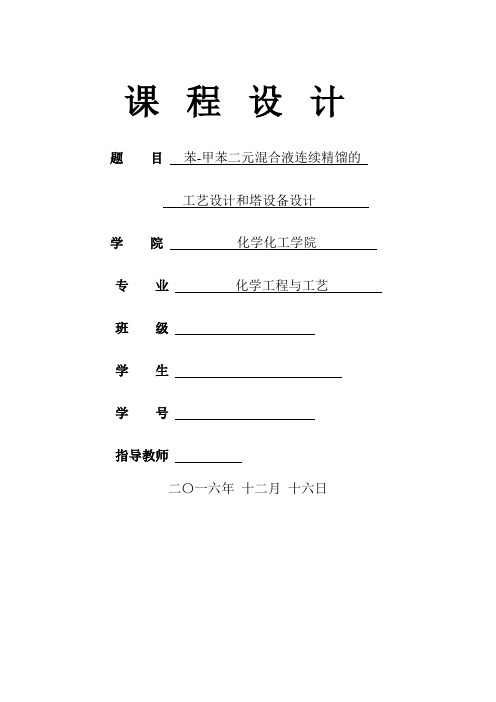
课程设计题目苯-甲苯二元混合液连续精馏的工艺设计和塔设备设计学院化学化工学院专业化学工程与工艺班级学生学号指导教师二〇一六年十二月十六日化工原理课程设计任务书一、设计课题:苯-甲苯二元混合液连续精馏的工艺设计和塔设备设计二、设计条件与工艺要求利用连续精馏装置,分离苯-甲苯二元混合液。
1、生产能力(以进料量计):60000吨/年2、料液组成:x AF =0.353、产品要求:=AD x 0.98, =AW x 0.02(注:浓度均指易挥发组分的摩尔分率)4、原料入塔时所指定的温度60℃5、设计用原始条件(1)操作压力:塔顶压力(表压)4kPa 。
(2)原料温度:原料原始温度20℃,经过与塔釜高温液体间接换热之后达到入塔时所指定的温度 。
(3)进料方式:在最适宜的进料板上连续进料。
(4)回流热状态:泡点回流。
(5)塔板压降:≤0.7kPa 。
(6)塔釜间接蒸汽加热,所用的加热蒸汽压力为200kP a (绝对压),仅利用其冷凝热。
(7)塔顶设全凝器,利用冷却水间接换热,冷却水的进口温度、出口温度分别为t in =25℃,t out =43℃ 。
(8)年工作日:300天。
三、设计内容1、苯-甲苯二元混合液连续精馏工艺流程的设计2、筛板精馏塔的工艺设计3、精馏附属设备的选型设计计算(1)计算塔釜加热蒸汽消耗量和塔顶冷凝器冷却水消耗量。
(2)估算塔釜所需换热面积和塔顶冷凝器所需换热面积。
(3)估算原料管路的阻力损失并确定原料泵的选型参数。
四、设计成果要求按照所指定的模板书写课程设计的说明书,包括封面、设计任务书、设计说明、目录、设计正文、设计总结及致谢语、参考文献。
目录要求内容层次分明。
设计正文中详细地表达各项内容的设计计算过程,均要求以文字说明作过程引导,在相关的内容中穿插入连续精馏装置工艺流程图、t~x(y)图、x~y图(图中包括进料线、精馏段操作线、提馏段操作线、图解法确定理论塔板数的过程)、精馏段塔板的负荷性能图、提馏段塔板的负荷性能图、筛板塔设计工艺条件图。
苯-甲苯连续精馏塔设计
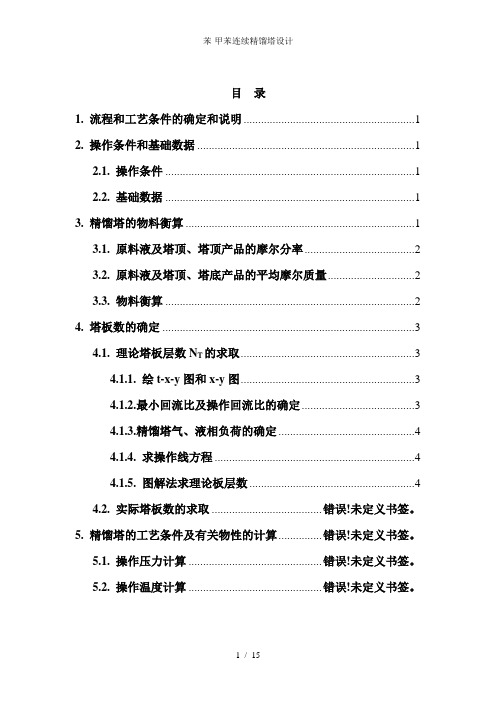
目录1. 流程和工艺条件的确定和说明 (1)2. 操作条件和基础数据 (1)2.1. 操作条件 (1)2.2. 基础数据 (1)3. 精馏塔的物料衡算 (1)3.1. 原料液及塔顶、塔顶产品的摩尔分率 (2)3.2. 原料液及塔顶、塔底产品的平均摩尔质量 (2)3.3. 物料衡算 (2)4. 塔板数的确定 (3)4.1. 理论塔板层数N T的求取 (3)4.1.1. 绘t-x-y图和x-y图 (3)4.1.2.最小回流比及操作回流比的确定 (3)4.1.3.精馏塔气、液相负荷的确定 (4)4.1.4. 求操作线方程 (4)4.1.5. 图解法求理论板层数 (4)4.2. 实际塔板数的求取 ...................................... 错误!未定义书签。
5. 精馏塔的工艺条件及有关物性的计算............... 错误!未定义书签。
5.1. 操作压力计算 .............................................. 错误!未定义书签。
5.2. 操作温度计算 .............................................. 错误!未定义书签。
6.设计实验评论 (11)7.参考文献 (12)8.附图(工艺流程简图、主体设备设计条件图) (12)摘要精馏塔作为一种工业生产使用的塔设备,在化工、医药、食品等行业得到广泛应用。
根据精馏原理可知,精馏塔实现精馏操作,必须同时拥有塔底再沸器和塔顶冷凝器,有时还有配原料液、预热器、回流液泵等附属设备。
本次设计根据实际操作条件,设计苯-甲苯连续精馏塔,即需设计一个精馏塔用来分离易挥发的苯和不易挥发的甲苯,采用连续操作方式,需设计一个筛板式塔将其分离。
综合工艺操作方便、经济及安全等多方面考虑,本设计采用塔板为碳钢材料,按照逐板计算求得理论板数为11。
塔顶使用全凝器,部分回流。
苯-甲苯溶液连续板式精馏塔设计说明书
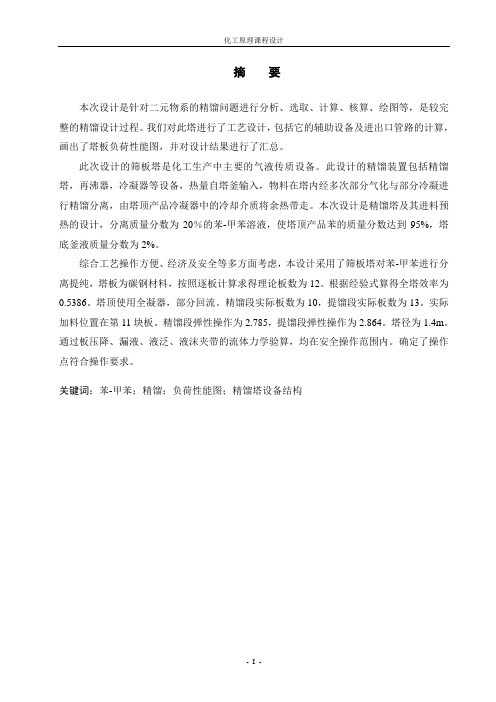
摘要本次设计是针对二元物系的精馏问题进行分析、选取、计算、核算、绘图等,是较完整的精馏设计过程。
我们对此塔进行了工艺设计,包括它的辅助设备及进出口管路的计算,画出了塔板负荷性能图,并对设计结果进行了汇总。
此次设计的筛板塔是化工生产中主要的气液传质设备。
此设计的精馏装置包括精馏塔,再沸器,冷凝器等设备,热量自塔釜输入,物料在塔内经多次部分气化与部分冷凝进行精馏分离,由塔顶产品冷凝器中的冷却介质将余热带走。
本次设计是精馏塔及其进料预热的设计,分离质量分数为20%的苯-甲苯溶液,使塔顶产品苯的质量分数达到95%,塔底釜液质量分数为2%。
综合工艺操作方便、经济及安全等多方面考虑,本设计采用了筛板塔对苯-甲苯进行分离提纯,塔板为碳钢材料,按照逐板计算求得理论板数为12。
根据经验式算得全塔效率为0.5386。
塔顶使用全凝器,部分回流。
精馏段实际板数为10,提馏段实际板数为13。
实际加料位置在第11块板。
精馏段弹性操作为2.785,提馏段弹性操作为2.864。
塔径为1.4m。
通过板压降、漏液、液泛、液沫夹带的流体力学验算,均在安全操作范围内。
确定了操作点符合操作要求。
关键词:苯-甲苯;精馏;负荷性能图;精馏塔设备结构AbstractThis design is in two yuan of the distillation analysis, selection, calculation, calculation and drawing, is a complete distillation design process. This tower was process design, including its auxiliary equipment and import and export pipeline calculation, draw plate load performance diagram, and the design results are summarized.The design of the sieve plate tower is the chemical industry in the production of gas-liquid mass transfer equipment. The design of rectifying device comprises a distillation column reboiler, condenser and other equipment, heat from the reactor input, material in the column after repeated partial gasification and partial condensation distillation separation by top product condenser cooling medium to heat away. The design of distillation column and its feed preheating design, separation and mass fraction of 20% benzene - toluene solution, so that the top product of quality score reaches 95%, the bottom of the tower kettle liquid quality fraction of 2%.Integrated process has the advantages of convenient operation, economy and safety and other aspects to consider, this design used the sieve plate column for benzene toluene by separating and purifying tower plate for carbon steel materials, according to the calculation of theoretical plate number by the board for 12. According to the experience type called full-tower efficiency is 0.5386. The use of full condenser, partial reflux. Rectifying section of actual plate number is 10, a stripping section actual plate number is 13. Practical feeding position on eleventh boards. Rectifying section elastic operation is 2.785,Stripping section elastic operation is 2.864. The tower diameter is 1.4m. Through the plate pressure drop, leakage, flooding and the entrainment of fluid mechanics calculation, is within the safe operating range. Determining an operating point into conformity with the operation requirements.Key words: Benzene- Toluene;Rectification;Load performance diagram;Distillation equipment structure前言课程设计是化工原理课程的一个非常重要的实践教学内容。
苯甲苯连续精馏塔设计

苯-甲苯连续精馏塔设计苯-甲苯连续精馏塔设计是一种涉及到化学工程、分离科学和工艺设计的复杂过程。
在设计这种精馏塔时,需要考虑到许多因素,包括原料的特性、产品的纯度、工艺流程的复杂性以及设备投资和运营成本等。
以下是设计苯-甲苯连续精馏塔的基本步骤:1.确定设计目标:首先,我们需要明确设计目标,例如,要得到高纯度的苯和甲苯产品。
2.收集原料和产品数据:我们需要收集关于苯和甲苯原料和产品的物理性质数据,包括沸点、相对挥发度、比热容、密度等。
3.确定理论板数:理论板数是精馏塔中的一种重要参数,可以根据原料和产品的沸点差来确定。
4.选择合适的塔盘:塔盘是精馏塔中的关键部件,其设计会影响到精馏效果和能耗。
在选择塔盘时,我们需要考虑到原料和产品的特性、流量和压力等参数。
5.确定进料位置:进料位置会影响到精馏效果和产品的质量,因此需要仔细选择。
在选择进料位置时,我们需要考虑到原料的特性和产品的质量要求。
6.确定回流比:回流比是影响精馏效果的重要参数,需要根据产品的纯度和能耗等因素来确定。
7.确定再沸器和冷凝器的热负荷:再沸器和冷凝器的热负荷是影响精馏效果和能耗的重要因素,需要根据产品的纯度和流量等因素来确定。
8.校核设备能力:在确定了各个参数之后,我们需要校核设备的能力,以确保它们能够满足工艺要求。
9.设计控制系统:最后,我们需要设计控制系统,以确保精馏过程能够稳定、高效地进行。
在具体设计时,还需要考虑到其他因素,例如设备投资和运营成本、操作便利性等。
同时,还需要进行模拟计算和优化,以得到最佳的设计方案。
此外,还需要注意遵守相关的环保和安全标准,以确保设计的安全性和可持续性。
总之,苯-甲苯连续精馏塔设计是一个复杂的过程,需要综合考虑多个因素。
只有在充分了解整个工艺流程和相关设备的特性,并进行模拟计算和优化之后,才能得到最佳的设计方案。
苯甲苯连续精馏筛板塔的设计
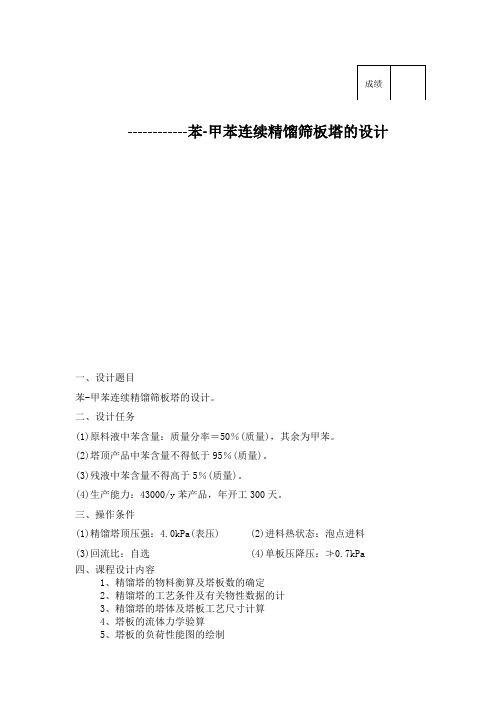
------------苯-甲苯连续精馏筛板塔的设计一、设计题目苯-甲苯连续精馏筛板塔的设计。
二、设计任务(1)原料液中苯含量:质量分率=50%(质量),其余为甲苯。
(2)塔顶产品中苯含量不得低于95%(质量)。
(3)残液中苯含量不得高于5%(质量)。
(4)生产能力:43000/y苯产品,年开工300天。
三、操作条件(1)精馏塔顶压强:4.0kPa(表压) (2)进料热状态:泡点进料(3)回流比:自选 (4)单板压降压:≯0.7kPa四、课程设计内容1、精馏塔的物料衡算及塔板数的确定2、精馏塔的工艺条件及有关物性数据的计3、精馏塔的塔体及塔板工艺尺寸计算4、塔板的流体力学验算5、塔板的负荷性能图的绘制6、精馏塔接管尺寸计算7、绘制带控制点的生产工艺流程图(A3 图纸)8、绘制主体设备图(A2图纸)五、课程设计的目的化工原理课程设计是一个综合性和实践性较强的教学环节,也是培养学生独立工作的有益实践,更是理论联系实际的有效手段。
通过课程设计达到如下目的:1.巩固化工原理课程学习的有关内容,并使它扩大化和系统化;2.培养学生计算技能及应用所学理论知识分析问题和解决问题的能力;3.熟悉化工工艺设计的基本步骤和方法;4.学习绘制简单的工艺流程图和主体设备工艺尺寸图;5.训练查阅参考资料及使用图表、手册的能力;6.通过对“适宜条件”的选择及对自己设计成果的评价,初步建立正确的设计思想,培养从工程技术观点出发考虑和处理工程实际问题的能力。
一、设计方案与工艺流程图1、设计方案本设计任务为分离苯-甲苯混合物。
对于二元混合物的分离,采用连续精馏流程。
设计中采用泡点进料,将原料液通过预热器加热至泡点后送人精馏塔内。
塔顶上升蒸气采用全凝器冷凝,冷凝液在泡点温度下一部分回流至塔内,其余部分产品经冷却器冷却后送至储罐。
该物系属易分离物系,最小回流比较小,故操作回流比取最小回流比的(1.1~2.0)倍。
塔釜采用间接蒸汽加热,塔底产品经冷却后送至储罐。
苯甲苯精馏塔设计方案
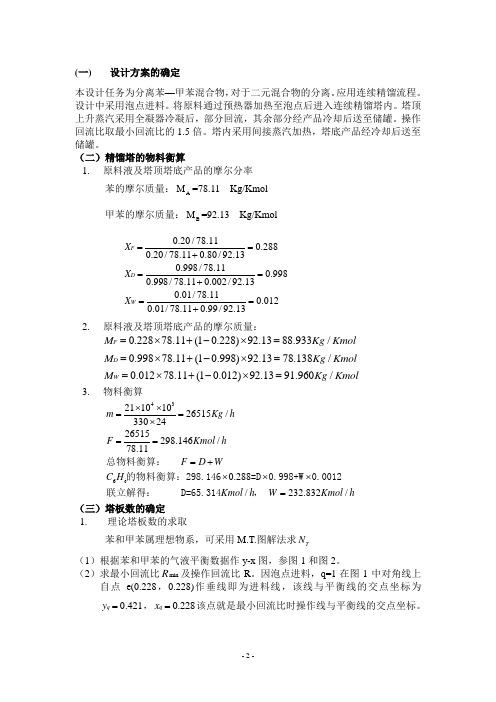
(一) 设计方案的确定本设计任务为分离苯—甲苯混合物,对于二元混合物的分离。
应用连续精馏流程。
设计中采用泡点进料。
将原料通过预热器加热至泡点后进入连续精馏塔内。
塔顶上升蒸汽采用全凝器冷凝后,部分回流,其余部分经产品冷却后送至储罐。
操作回流比取最小回流比的1.5倍。
塔内采用间接蒸汽加热,塔底产品经冷却后送至储罐。
(二)精馏塔的物料衡算1. 原料液及塔顶塔底产品的摩尔分率苯的摩尔质量:A M =78.11 Kg/Kmol 甲苯的摩尔质量:B M =92.13 Kg/Kmol0.20/78.110.2880.20/78.110.80/92.130.998/78.110.9980.998/78.110.002/92.130.01/78.110.0120.01/78.110.99/92.13F D W X X X ==+==+==+ 2. 原料液及塔顶塔底产品的摩尔质量:0.22878.11(10.228)92.1388.933/0.99878.11(10.998)92.1378.138/0.01278.11(10.012)92.1391.960/F D W M Kg Kmol M Kg Kmol M Kg Kmol=⨯+-⨯==⨯+-⨯==⨯+-⨯= 3.物料衡算643621101026515/3302426515298.146/78.110.288/232.832/m Kg hF Kmol hF D WC H Kmol h W Kmol h⨯⨯==⨯===+⨯⨯⨯=总物料衡算: 的物料衡算:298.146=D 0.998+W 0.0012联立解得: D=65.314,(三)塔板数的确定1. 理论塔板数的求取苯和甲苯属理想物系,可采用M.T.图解法求T N(1)根据苯和甲苯的气液平衡数据作y-x 图,参图1和图2。
(2)求最小回流比min R 及操作回流比R 。
因泡点进料,q=1在图1中对角线上自点e(0.228,0.228)作垂线即为进料线,该线与平衡线的交点坐标为0.421q y =,0.228q x =该点就是最小回流比时操作线与平衡线的交点坐标。
苯甲苯连续精馏塔机械设计
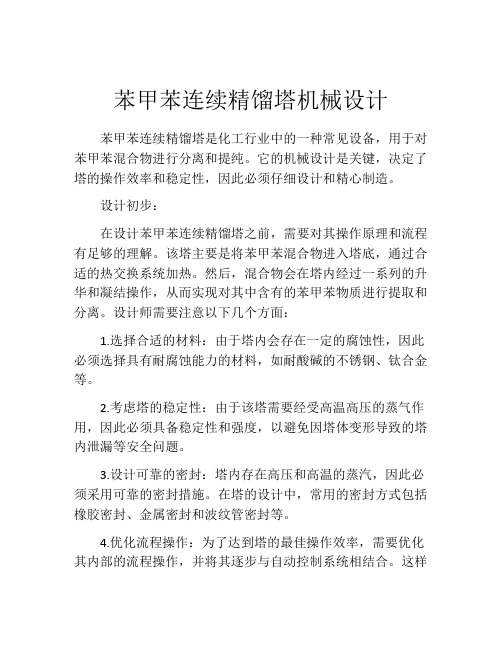
苯甲苯连续精馏塔机械设计苯甲苯连续精馏塔是化工行业中的一种常见设备,用于对苯甲苯混合物进行分离和提纯。
它的机械设计是关键,决定了塔的操作效率和稳定性,因此必须仔细设计和精心制造。
设计初步:在设计苯甲苯连续精馏塔之前,需要对其操作原理和流程有足够的理解。
该塔主要是将苯甲苯混合物进入塔底,通过合适的热交换系统加热。
然后,混合物会在塔内经过一系列的升华和凝结操作,从而实现对其中含有的苯甲苯物质进行提取和分离。
设计师需要注意以下几个方面:1.选择合适的材料:由于塔内会存在一定的腐蚀性,因此必须选择具有耐腐蚀能力的材料,如耐酸碱的不锈钢、钛合金等。
2.考虑塔的稳定性:由于该塔需要经受高温高压的蒸气作用,因此必须具备稳定性和强度,以避免因塔体变形导致的塔内泄漏等安全问题。
3.设计可靠的密封:塔内存在高压和高温的蒸汽,因此必须采用可靠的密封措施。
在塔的设计中,常用的密封方式包括橡胶密封、金属密封和波纹管密封等。
4.优化流程操作:为了达到塔的最佳操作效率,需要优化其内部的流程操作,并将其逐步与自动控制系统相结合。
这样可以更好地通过调整流量、温度和压力控制塔内的操作过程,从而提高操作效率和稳定性。
设计思路:苯甲苯连续精馏塔的机械设计需要按照稳定性为主,考虑合适的压力和温度控制,保证塔内的操作效率;同时也需要保证操作者的安全。
1.选择合适的材料:在材料的选择上,需选择耐高温、高压和耐腐蚀性强的材料,如钛合金、不锈钢等。
这些材料在工业生产中比较常用,在设计塔的时候应当选择符合实际条件的材料。
2.考虑塔的稳定性:在塔的设计上,要考虑到其稳定性和强度。
为了保证在高温高压下塔体不变形,塔体的设计应尽可能简洁和坚固,同时在内部加强支撑结构,以避免因塔体变形导致的塔内泄漏等安全问题。
3.设计可靠的密封:塔内存在高压和高温的蒸汽,因此必须采用可靠的密封措施。
在塔的设计中,常用的密封方式包括弹性密封、金属密封和波纹管密封等。
在选择时,应根据实际的操作情况进行选择,确保密封稳定可靠。
苯-甲苯混合液常压连续精馏塔设计

苯一甲苯混合液常压连续精馏塔设计序言化工原理课程设计是综合运用《化工原理》课程和《物理化学》,《化工制图》等所学知识,完成一个单元设备设计为主的一次性实践教学,是理论联系实际的桥梁,在整个教学中起着培养学生能力的重要作用。
通过课程设计,要求更加熟悉工程设计的基本内容,掌握化工单元操作设计的主要程序及方法,锻炼和提高学生综合运用理论知识和技能的能力,问题分析能力,思考问题能力,计算能力等。
精馏是分离液体混合物最常用的一种单元操作,在化工,炼油,石化等工业中得到广泛应用。
精馏过程是利用两组份挥发度的差异实现连续的高纯度分离。
本设计的题目是苯一甲苯混合液常压连续精馏塔设计,即设计一个精馏塔用来在常压下分离易挥发的苯和不易挥发的甲苯,采用连续操作。
精馏塔设计任务书一、设计题目苯一甲苯混合液常压连续精馏塔设计二、设计任务(1)原料液中苯含量:质量分数为41%,甲苯含量为59%。
(2)塔顶馏出液中轻组分含量不低于96%,釜液中重组分含量不低于96%。
(3)生产能力:80t/d原料量,年开工310天,每天工作20小时。
(4)精馏方式:筛板塔常压精馏。
三、操作条件(1)精馏塔顶压强:4.0kpa(2)进料热状态:泡点进料(3)回流比:自选(4)单板压降:>0.7kpa四、设计内容(1)实际塔板数的确定,加料板位置的确定,塔高的计算,塔径的计算 (4)根据物料衡算和能量衡算,选择管路流动路线,管路尺寸,材料,管路中所需泵的型号。
一、工艺计算1.1设计方案的选定及基础数据的搜集该二元物系属易挥发物系,最小回流比小,故操作回流比取最小回流比的2倍。
表3常温下苯一甲苯气液平衡数据91.40 50.0 71.3 90.11 55.0 75.5 80.80 60.0 79.1 87.63 65.0 82.5 86.52 70.0 85.7 85.44 75.0 88.5 84.40 80.0 91.2 83.33 85.0 93.6 82.25 90.0 95.9 81.11 95.0 98.0 80.66 97.0 98.8 80.21 99.0 99.61 80.01100.0100.0=0.4500.966 0.047 X w1.2精馏塔的物料衡算a. 原料液及塔顶、塔底产品的摩尔分率苯的摩尔质量仏=78.11枚/Awo / 甲苯的摩尔质量仏=92.13^/Awo /0.41/78.11 0.41/78.11 + 0.59/92.130.96/78.110.96/78.11 +0.04/92.130.04/78.110.04/78.11 + 0.96/92.13b. 原料及塔顶、塔底产品的平均摩尔质量M F = 0.450x 78.11 + (1 -0.450) x 92.13 = 85.82 M D = 0.966x 78.11 + (1 -0.966)x 92.13 = 78.59 M W = 0.047x 78.11 + (1 - 0.047)x 92.13 = 91.47 c. 物料衡算 原料处理量F =80000= 46.61( kmol / h )85.82 x 20总物料衡算D +妒= 46.61 苯物料衡算 0.450F = 0.966D + 0.047妒 联立方程1和2得 D = 20.44 W = 26.17 式中F ------原料液流量D ------ 塔顶液流量 W ------塔底液流量1.3塔板数的确定采用逐板计算法求取理论塔板数%a .求最小回流比和操作回流比 利用恩特伍德方程q =1取^. =2.47则对二元物系a jy =1 解恩特伍德方程得 6= 1.487Rnn = 136取操作回流比R = 2x 1.36 = 2.72 b .求精馏塔的液、气相负荷 L = RD =2.72x 20.44 = 55.60V = (R +1) D = (2.72 +1) x 20.44 = 76.04h - -R +1 m务.Fi、i =\ a i 「6=1 - q 式中a ——相对挥发度V = (R + \)D - (1 - q)F = (2.72 +1) x 20.44 = 76.04 L = RD + qF = 2.72 x 20.44 +1 x 46.61 = 102.21 c.求操作线方程精馏段操作线方程y n+1RR+1 X n +XD =R+10.731x n +0.260提馏段操作线方程y n+1V1 X n V 1.344x n - 0.016 d.逐板法求理论板数相平衡方程 2.47 xy变形得x: y1 +1.47x 2.47-1.47y取精馏段操作线方程和相平衡方程作逐板计算y t = x D = 0.966 ,Xj y:0.9662.47 -1.47y t 2.47-1.47 x 0.9660.920y2 = 0.731x1 + 0.260 = 0.933,x2 = y3 = 0.731x2 + 0.260 = 0.880 ,x3: y4 = 0.731x3 + 0.260 = 0.807 ,x4 y5 = 0.731x4 + 0.260 = 0.719 ,x5y6 = 0.731x5 + 0.260 = 0.632 ,x6因为,x6 = 0.411 < XF = 0.450故精馏段理论塔板数为5y22.47 -1.47y20.848y32.47 -1.47y30.748y42.47 -1.47y40.629y52.47 -1.47y50.509y62.47 -1.47y60.411y 7 = 1.344x 6 -0.016 = 0.536X7y 72.47 -1.47y 70.319y 8 = 1.344x 7 - 0.016 = 0.413 , x 8y 82.47 -1.47y 80.221y 9 = 1.344x 9 - 0.016 = 0.282 , x 9y 92.47 -1.47y 90.137y 10 = 1.344x 9 - 0.016 = 0.168 , x 1Cy :02.47-1.47y K0.076y ll = 1.344x 10 -0.016 = 0.086 , x ny:12.47 -1.47y … 0.037,得到 t F =93.4°C ,得到 t D = 80.88 °C 全塔平均温度用提馏段操作线方程和相平衡方程作逐板计算因为,x …= 0.037 <x w = 0.047提馏段所需理论踏板数为11 所需理论塔板数为11块。
苯与甲苯混合物精馏塔设计方案
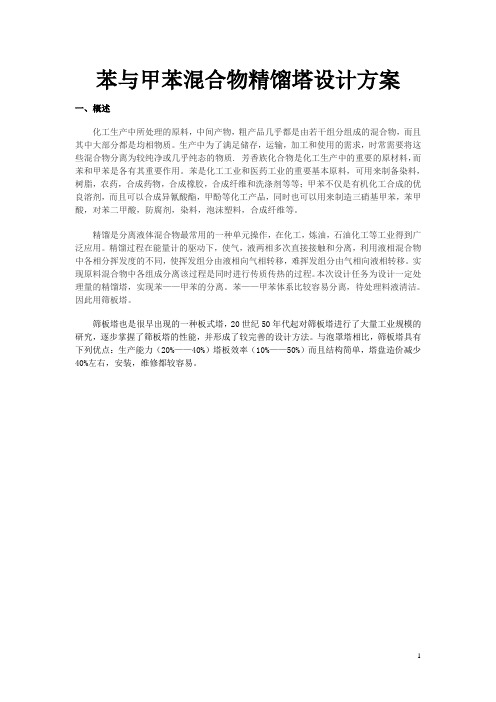
苯与甲苯混合物精馏塔设计方案一、概述化工生产中所处理的原料,中间产物,粗产品几乎都是由若干组分组成的混合物,而且其中大部分都是均相物质。
生产中为了满足储存,运输,加工和使用的需求,时常需要将这些混合物分离为较纯净或几乎纯态的物质. 芳香族化合物是化工生产中的重要的原材料,而苯和甲苯是各有其重要作用。
苯是化工工业和医药工业的重要基本原料,可用来制备染料,树脂,农药,合成药物,合成橡胶,合成纤维和洗涤剂等等;甲苯不仅是有机化工合成的优良溶剂,而且可以合成异氰酸酯,甲酚等化工产品,同时也可以用来制造三硝基甲苯,苯甲酸,对苯二甲酸,防腐剂,染料,泡沫塑料,合成纤维等。
精馏是分离液体混合物最常用的一种单元操作,在化工,炼油,石油化工等工业得到广泛应用。
精馏过程在能量计的驱动下,使气,液两相多次直接接触和分离,利用液相混合物中各相分挥发度的不同,使挥发组分由液相向气相转移,难挥发组分由气相向液相转移。
实现原料混合物中各组成分离该过程是同时进行传质传热的过程。
本次设计任务为设计一定处理量的精馏塔,实现苯——甲苯的分离。
苯——甲苯体系比较容易分离,待处理料液清洁。
因此用筛板塔。
筛板塔也是很早出现的一种板式塔,20世纪50年代起对筛板塔进行了大量工业规模的研究,逐步掌握了筛板塔的性能,并形成了较完善的设计方法。
与泡罩塔相比,筛板塔具有下列优点:生产能力(20%——40%)塔板效率(10%——50%)而且结构简单,塔盘造价减少40%左右,安装,维修都较容易。
二、设计方案的确定本设计任务为分苯—甲苯的混合物,对于二元混合物的分离,应采用连续常压精馏流程。
设计中采用泡点进料,将原料液通过预热器加热至泡点后送入精馏塔内。
塔顶上升蒸气采用全凝器冷凝,冷凝液在泡点下一部分回流至塔内,其余部分经产品冷凝器冷却后送至贮罐。
该物系属于易分离物系,故操作回流比取为2.7。
塔底采用直接蒸气加热,塔底产品经冷却后送至贮罐。
三、精馏塔的物料衡算⒈ 原料液及其塔顶、塔底产品的摩尔分率苯的摩尔质量为: 78.11/kg kmol甲苯的摩尔质量为: 92.13/kg kmol 0.55/78.110.590.55/78.110.45/92.13F x ==+ 0.995D x =0.01W x =⒉ 原料液及其塔顶与塔底产品的平均摩尔质量 0.5978.11(10.59)92.1383.86/F M kg kmol =⨯+-⨯=0.99578.11(10.995)92.1378.18/D M kg kmol =⨯+-⨯=0.0178.11(10.01)92.1391.99/W M kg kmol =⨯+-⨯=⒊物料平衡原料处理量 600071.55/83.86F kmol h ==总物料衡算 71.55D W =+苯物料衡算 71.550.590.9950.01D W ⨯=+联立解得 42.13/D kmol h =29.42/W kmol h =四、塔板数的确定⒈ 理论板层数N T 的求取①因为苯—甲苯属于理想物系,可采用图解法求解理论板层数②操作回流比 1.8R =③求精馏塔的气、液相负荷1.842.1375.83/L RD kmol h ==⨯=(1) 2.842.13117.96/V R D kmol h =+=⨯=75.8371.55147.38/L L qF L F kmol h =+=+=+= 117.96/V V kmol h ==④求操作线方程精馏段操作线方程为75.8342.130.9950.6430.357117.96117.96D LDy x x x x V V =+=+⨯=+提馏段操作线方程为 147.3829.420.01 1.2490.0025117.96117.96W LWy x x x x V V ''''=-=-⨯=-⑤图解法求理论塔板层数采用图解法求理论板层数,求解结果为总理论板层数 18.5T N =(包括再沸器)进料板位置 10F N =⒉ 理论板层数T N 的求取精馏段实际板层数 9/70%12.8613N ==≈精提馏段实际板层数 9.5/70%13.6714N ==≈提五、精馏塔的工艺条件及有关物性数据数据的计算⒈ 操作压力的计算操作为常压操作,所以 101.3P KPa =⒉ 操作温度的计算依据安托因方程苯 1206.35log 6.023220.24o A P t =-+甲苯 1343.94log 6.078219.58o B P t =-+又 o oA AB B P P x P x =+所以 塔顶温度 80.3D t =℃进料板温度 91.0F t =℃塔底温度 110.2W t =℃精馏段平均温度 80.391.085.652m t +==℃提馏段平均温度 91.110.2'100.62m t +==℃⒊ 平均摩尔质量的计算塔顶平均摩尔质量计算由10.995D x y ==查平衡曲线得 10.985x =0.99578.11(10.995)92.1378.18/VDm M kg kmol=⨯+-⨯= 0.98578.11(10.985)92.1378.32/LDm M kg kmol=⨯+-⨯= 进料板平均摩尔质量计算由0.742F y = 查平衡曲线得 0.535F x =0.74278.11(10.742)92.1381.73/VFm M kg kmol =⨯+-⨯=0.53578.11(10.535)92.1384.63/LFm M kg kmol=⨯+-⨯= 塔底平均摩尔质量计算由20.01W x y == 查平衡曲线得 20.004x =0.0178.11(10.01)92.1391.99/VWm M kg kmol =⨯+-⨯=0.00478.11(10.004)92.1392.07/LWm M kg kmol=⨯+-⨯= 精馏段平均摩尔质量 78.1881.7379.96/2Vm M kg kmol +== 78.3284.6381.48/2Lm M kg kmol +==提馏段平均摩尔质量81.7391.99'86.86/2Vm M kg kmol +== 84.6392.07'88.35/2Lm M kg kmol +==⒋ 平均密度的计算⑴气相平均密度计算由理想气体状态方程计算,即精馏段气相平均密度3101.379.962.72/8.3145(85.65273.15)m VmVm m P M kg m RT ρ⨯===⨯+提馏段气相平均密度3'101.386.86' 2.83/'8.314(100.6273.15)m Vm Vm m PM kg m RT ρ⨯===⨯+⑵液相平均密度计算液相平均密度依下式计算,即 1i Lm ia ρρ=∑塔顶液相平均密度的计算由80.3D t =℃,查手册得3814.7/A kg m ρ= 3809.7/B kg m ρ= 31814.67/(0.995/814.80.005/809.7)LDm kg m ρ==+进料板液相平均密度的计算由91.0F t =℃,查手册得3802.8/A kg m ρ= 3799.2/B kg m ρ=进料板液相的质量分率0.53578.110.4940.53578.110.46592.13A a ⨯==⨯+⨯31800.97/(0.494/802.80.506/799.2)LFm kg m ρ==+塔底液相平均密度的计算由110.2W t =℃,查手册得3780.1/A kg m ρ= 3780.1/B k g m ρ=塔底液相的质量分率0.00478.110.00340.00478.110.99692.13AW a ⨯==⨯+⨯31780.1/(0.0034/780.10.9966/780.1)LWm kg m ρ==+精馏段液相平均密度为 3814.67800.97807.82/2Lm kg m ρ+==提馏段液相平均密度为 3800.97780.1'790.54/2Lm kg m ρ+==⒌ 液体平均表面张力的计算液相平均表面张力依下式计算 即Lm i i x σσ=∑塔顶液相平均表面张力的计算由80.3D t =℃,查手册得21.23/A mN m σ= 21.66/B mN m σ=0.99521.230.00521.6621.23/LDm mN mσ=⨯+⨯= 进料板液相平均表面张力的计算由91.0F t =℃,查手册得19.94/A mN m σ= 20.53/B mN m σ=0.53519.940.46520.5320.21/LFm mN m σ=⨯+⨯=塔底液相平均表面张力的计算由110.2W t =℃,查手册得17.65/A mN m σ= 18.4/B mN m σ=0.0117.650.9918.418.39/LWm mN m σ=⨯+⨯=精馏段液相平均表面张力 21.2320.2120.72/2Lm mN m σ+==提馏段液相平均表面张力20.2118.39'19.30/2Lm mN m σ+==⒍ 液体平均粘度的计算液相平均粘度依下式计算 即lg lg Lm i i x μμ=∑塔顶液相平均粘度的计算由80.3D t =℃,查手册得0.307A mPa s μ=⋅ 0.310B mPa s μ=⋅lg 0.995lg0.3070.005lg0.310LDm μ=⨯+⨯解出 0.307LDm mPa s μ=⋅进料板平均粘度的计算由91.0F t =℃,查手册得0.277A mPa s μ=⋅ 0.284B mPa s μ=⋅lg 0.494lg0.2770.506lg0.284LFm μ=⨯+⨯解出 0.280LFm mPa s μ=⋅由110.2W t =℃,查手册得0.232A mPa s μ=⋅ 0.252B mPa s μ=⋅lg 0.01lg0.2330.99lg0.252LWm μ=⨯+⨯解出 0.252L W m m P a s μ=⋅精馏段平均粘度0.3070.2800.2942Lm mPa s μ+==⋅提馏段平均粘度0.2800.252'0.2662Lm mPa s μ+==⋅六、精馏塔的塔体工艺尺寸计算由上面可知精馏段 75.83/L kmol h =117.96/V kmol h =⒈ 塔径的计算精馏段的气、液相体积流率为3117.9679.960.963/36003600 2.72Vms Vm VM V m s ρ⨯===⨯ 375.8381.480.00212/36003600807.82Lm s Lm LM L m sρ⨯===⨯由max u =式中,负荷因子0.220()20L C C σ=由史密斯关联图查得20C ,图的横坐标为1/21/20.002123600807.82()()0.03790.9633600 2.72s L s V L V ρρ⨯=⨯=⨯ 取板间距0.40T H m =,板上清液层高度取0.06L h m =,则0.34T L H h m -=由史密斯关联图,得知 200.072C =气体负荷因子 0.20.22020.72()0.072()0.07252020LC C σ==⨯=max 0.0725 1.250/u m s == 取安全系数为0.7,则空塔气速为max 0.70.7 1.2500.875/u u m s ==⨯=1.184D m === 按标准塔径圆整后为 1.2D m =塔截面积为 221.134T A D m π==实际空塔气速为 0.9630.852/1.13u m s == 提馏段的气、液相体积流率为3117.9686.86' 1.006/36003600 2.83Vm s Vm VM V m s ρ⨯===⨯ 3147.3888.35'0.00458/36003600790.54Lm s Lm LM L m s ρ⨯===⨯由max u =式中,负荷因子0.220()20L C C σ=由史密斯关联图查得20C ,图的横坐标为1/21/2'0.004583600790.54()()0.0761' 1.0063600 2.83s L s V L V ρρ⨯=⨯=⨯ 取板间距0.45T H m =,板上清液层高度取0.06L h m =,则0.39T L H h m -=由史密斯关联图,得知 200.081C =气体负荷因子 0.20.22019.30()0.081()0.08042020L C C σ==⨯=max 0.0804 1.34/u m s == 取安全系数为0.7,则空塔气速为max 0.70.7 1.340.938/u u m s ==⨯=1.17D m === 按标准塔径圆整后为 1.2D m =塔截面积为 221.134T A D m π==实际空塔气速为 1.0060.89/1.13u m s == ⒉ 精馏塔有效高度的计算精馏段有效高度为 (1)(131)0.4 4.8T Z N H m =-=-⨯=精精提馏段有效高度为 (1)(141)0.45 5.85T Z N H m =-=-⨯=提提在进料板上方开一个人孔,其高度为0.55m故精馏塔有效高度为0.5511.2Z Z Z m =++=精提七、塔板主要工艺尺寸的计算⒈ 溢流装置计算精馏段:因塔径 1.2D m =,所以可选取单溢流弓形降液管,采用凹形受液盘。
化工原理课程设计苯甲苯连续精馏塔的设计

目录
• 项目背景与要求 • 精馏塔工艺流程设计 • 塔体结构设计与选型 • 控制系统设计 • 安全防护措施与环保要求 • 经济评价与总结展望
01
项目背景与要求
苯甲苯连续精馏塔简介
苯甲苯连续精馏塔是化工生产中常用的一种分离设备,用于将苯甲苯混合物中的各 组分进行分离提纯。
塔体类型选择及优缺点分析
板式塔
结构简单,造价低,易于维护, 适用于中小规模的精馏操作。但 处理量大时效率较低,塔板压降 较大。
填料塔
处理能力大,分离效考虑到苯甲苯连续精馏塔的处理 量和分离要求,板式塔更适合本 次设计。
塔径、塔高计算及校核
改进方向探讨
针对存在的问题,提出改进措施和优化方案,如改进 设备结构、优化工艺流程、提高自动化水平等,以提 高苯甲苯连续精馏塔的性能和经济效益。同时,探讨 未来苯甲苯连续精馏技术的发展趋势和前景,为相关 领域的研究提供参考。
THANKS
感谢观看
节能减排技术应用
节能技术
采用高效传热、传质设备和节能型电器,优 化工艺流程和操作参数,降低精馏过程的能 耗。
减排技术
通过改进精馏塔结构、优化操作条件和采用先进的 分离技术,提高产品的纯度和收率,减少废弃物和 污染物的排放。
资源回收利用
对精馏过程中产生的余热、余压等资源进行 回收利用,提高能源利用效率,降低生产成 本。
行。
05
安全防护措施与环保要求
安全防护措施(如防火、防爆等)
防火措施
采用阻燃材料和防火涂料,设置火灾自动报警系统和灭火装置,确保塔体、管道和设备 的防火安全。
防爆措施
严格控制塔内操作温度和压力,避免可燃气体泄漏和积聚,采用防爆电器和照明设备, 设置安全泄放装置,以防止爆炸事故的发生。
苯_甲苯的分离过程连续板式精馏塔设计书
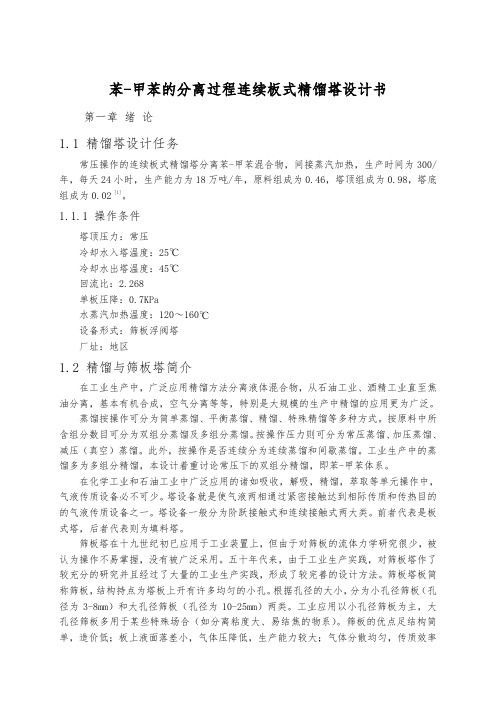
苯-甲苯的分离过程连续板式精馏塔设计书第一章绪论1.1 精馏塔设计任务常压操作的连续板式精馏塔分离苯-甲苯混合物,间接蒸汽加热,生产时间为300/年,每天24小时,生产能力为18万吨/年,原料组成为0.46,塔顶组成为0.98,塔底组成为0.02 [1]。
1.1.1 操作条件塔顶压力:常压冷却水入塔温度:25℃冷却水出塔温度:45℃回流比:2.268单板压降:0.7KPa水蒸汽加热温度:120~160℃设备形式:筛板浮阀塔厂址:地区1.2 精馏与筛板塔简介在工业生产中,广泛应用精馏方法分离液体混合物,从石油工业、酒精工业直至焦油分离,基本有机合成,空气分离等等,特别是大规模的生产中精馏的应用更为广泛。
蒸馏按操作可分为简单蒸馏、平衡蒸馏、精馏、特殊精馏等多种方式。
按原料中所含组分数目可分为双组分蒸馏及多组分蒸馏。
按操作压力则可分为常压蒸馏、加压蒸馏、减压(真空)蒸馏。
此外,按操作是否连续分为连续蒸馏和间歇蒸馏。
工业生产中的蒸馏多为多组分精馏,本设计着重讨论常压下的双组分精馏,即苯-甲苯体系。
在化学工业和石油工业中广泛应用的诸如吸收,解吸,精馏,萃取等单元操作中,气液传质设备必不可少。
塔设备就是使气液两相通过紧密接触达到相际传质和传热目的的气液传质设备之一。
塔设备一般分为阶跃接触式和连续接触式两大类。
前者代表是板式塔,后者代表则为填料塔。
筛板塔在十九世纪初已应用于工业装置上,但由于对筛板的流体力学研究很少,被认为操作不易掌握,没有被广泛采用。
五十年代来,由于工业生产实践,对筛板塔作了较充分的研究并且经过了大量的工业生产实践,形成了较完善的设计方法。
筛板塔板简称筛板,结构持点为塔板上开有许多均匀的小孔。
根据孔径的大小,分为小孔径筛板(孔径为3-8mm)和大孔径筛板(孔径为10-25mm)两类。
工业应用以小孔径筛板为主,大孔径筛板多用于某些特殊场合(如分离粘度大、易结焦的物系)。
筛板的优点足结构简单,造价低;板上液面落差小,气体压降低,生产能力较大;气体分散均匀,传质效率较高。
苯与甲苯连续精馏塔设计方案青海大学)
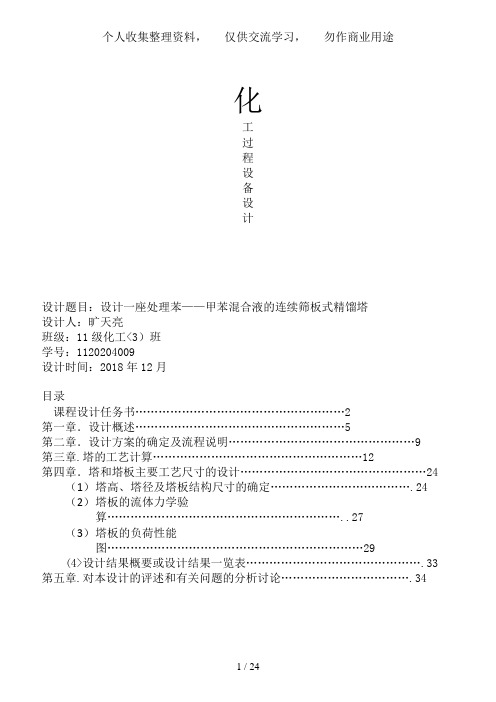
化工过程设备设计设计题目:设计一座处理苯——甲苯混合液的连续筛板式精馏塔设计人:旷天亮班级:11级化工<3)班学号:1120204009设计时间:2018年12月目录课程设计任务书 (2)第一章.设计概述 (5)第二章.设计方案的确定及流程说明 (9)第三章.塔的工艺计算 (12)第四章.塔和塔板主要工艺尺寸的设计 (24)(1)塔高、塔径及塔板结构尺寸的确定 (24)(2)塔板的流体力学验算 (27)(3)塔板的负荷性能图 (29)(4>设计结果概要或设计结果一览表 (33)第五章.对本设计的评述和有关问题的分析讨论 (34)《化工原理课程设计二》任务书(1>(一)设计题目:试设计一座苯—甲苯连续精馏塔,要求进料量5吨/小时,塔顶馏出液中苯含量不低于99%,塔底馏出液中苯含量不高于2%,原料液中含苯41%<以上均为质量%)。
<二)操作条件<1)塔顶压强 4kPa<表压)<2)进料热状况气液混合进料<液:气=1:2)<3)回流比自选<4)单板压降不大于0.7kPa<三)设备型式:筛板塔<四)设备工作日:每年330天,每天24小时连续运行<五)厂址:西宁地区<六)设计要求:1、概述2、设计方案的确定及流程说明3、塔的工艺计算4、塔和塔板主要工艺尺寸的设计(1)塔高、塔径及塔板结构尺寸的确定;(2)塔板的流体力学验算(3)塔板的负荷性能图5、设计结果概要或设计结果一览表6、对本设计的评述和有关问题的分析讨论(二)(三)(四) log P0=A-C t B(五) 式中 t ——物系温度,℃ P0——饱和蒸汽压,kPa A 、B 、(七)(八)(九)(十)(十二)(十三)第一章.设计概述一.塔设备的类型。
塔设备是化工、炼油生产中重要的设备之一。
塔设备的设计和研究,已经受到化工行业的极大重视。
在化工生产中,塔设备的性能对于整个装置的产品产量、质量、生产能力和消耗定额,以及三废处理和环境保护等各个方面,都有非常重大的影响。
- 1、下载文档前请自行甄别文档内容的完整性,平台不提供额外的编辑、内容补充、找答案等附加服务。
- 2、"仅部分预览"的文档,不可在线预览部分如存在完整性等问题,可反馈申请退款(可完整预览的文档不适用该条件!)。
- 3、如文档侵犯您的权益,请联系客服反馈,我们会尽快为您处理(人工客服工作时间:9:00-18:30)。
II
化工原理课程设计说明书
目摘Βιβλιοθήκη 录要................................................................................................................................I
ABSTRACT......................................................................................................................II 1 绪论............................................................................................................................... 1 2 设计方案的确定........................................................................................................... 3 2.1 设计流程............................................................................................................. 3 2.2 设计要求............................................................................................................. 3 2.3 设计思路............................................................................................................. 4 2.4 相关符号说明..................................................................................................... 5 3 塔板的工艺设计........................................................................................................... 6 3.1 设计方案的确定................................................................................................. 6 3.2 塔的工艺计算..................................................................................................... 6 3.2.1 物料衡算................................................................................................... 6 3.2.2 精馏塔的气液相负荷............................................................................... 8 3.2.3 操作线方程............................................................................................... 9 3.2.4 用逐板法算理论板数............................................................................... 9 3.2.5 实际板数的求取..................................................................................... 10 3.3 精馏塔的工艺条件及有关物性数据的计算................................................... 11 3.3.1 进料温度的计算..................................................................................... 11 3.3.2 操作压强................................................................................................. 11 3.3.3 平均摩尔质量......................................................................................... 11 3.3.4 平均密度计算......................................................................................... 12 3.3.5 液体平均表面张力的计算..................................................................... 14 3.3.6 液体平均黏度计算................................................................................. 14 3.4 精馏塔工艺尺寸的计算................................................................................... 15 3.4.1 塔径的计算............................................................................................. 15 3.4.2 精馏塔有效高度的计算......................................................................... 17 3.5 塔板主要工艺尺寸的计算............................................................................... 18 3.5.1 精馏段溢流装置计算............................................................................. 18
化工原理课程设计说明书
摘
要
目前用于气液分离的传质设备主要采用板式塔,对于二元混合物的分离,应采用连 续精馏过程。浮阀塔在操作弹性、塔板效率、压降、生产能力以及设备造价等方面都比 较优越。其主要特点是在塔板的开孔上装有可浮动的浮阀,气流从浮阀周边以稳定的速 度水平进入塔板上液层进行两相接触, 浮阀可根据气体流量的大小上下浮动, 自行调节。 其中精馏塔的工艺设计计算包括塔高、 塔径、 塔板各部分尺寸的设计计算, 塔板的布置, 塔板流体力学性能的校核及绘出塔板的性能负荷图。 关键词:气液传质分离;精馏;浮阀塔
V
化工原理课程设计说明书
3.5.2 提馏段溢流装置计算............................................................................. 20 3.6 塔板流体力学验算........................................................................................... 22 3.6.1 精馏段流体力验算................................................................................. 22 3.6.2 提馏段流体力验算................................................................................. 24 3.7 塔板负荷性能图............................................................................................... 26 3.7.1 精馏段负荷性能图................................................................................. 26 3.7.2 提馏段负荷性能图................................................................................. 29 4 热量衡算..................................................................................................................... 32 4.1 相关介质的选择............................................................................................... 32 4.1.1 加热介质的选择..................................................................................... 32 4.1.2 冷凝剂..................................................................................................... 32 4.2 蒸发潜热衡算................................................................................................... 32 4.2.1 塔顶热量................................................................................................. 32 4.2.2 塔底热量................................................................................................. 33 4.3 焓值衡算........................................................................................................... 35 5 辅助设备的选型......................................................................................................... 38 5.1 冷凝器的选型................................................................................................... 38 5.2 冷凝器的传热面积和冷却水的用量............................................................... 38 5.3 选用釜式再沸器............................................................................................... 39 6 塔附件设计计算......................................................................................................... 40 6.1 接管................................................................................................................... 40 6.1.1 进料管..................................................................................................... 40 6.1.2 回流管..................................................................................................... 40 6.1.3 塔顶蒸汽接管......................................................................................... 41 6.1.4 釜液排出管............................................................................................. 41 6.1.5 塔釜进气管............................................................................................. 42 6.2 塔总体高度的设计........................................................................................... 42 7 安全与环保................................................................................................................. 43 7.1 安全注意事项................................................................................................... 43
